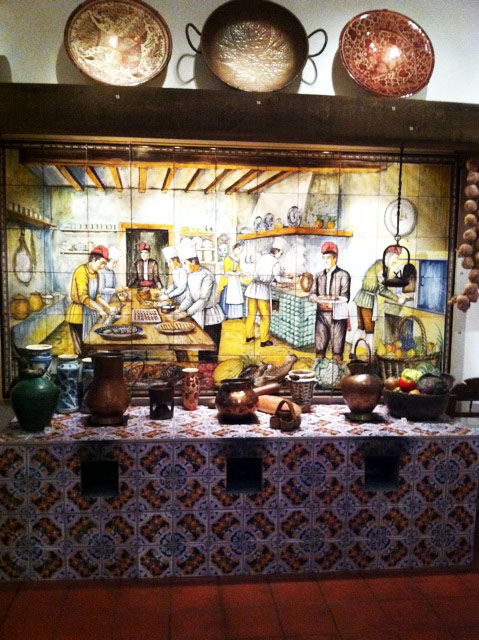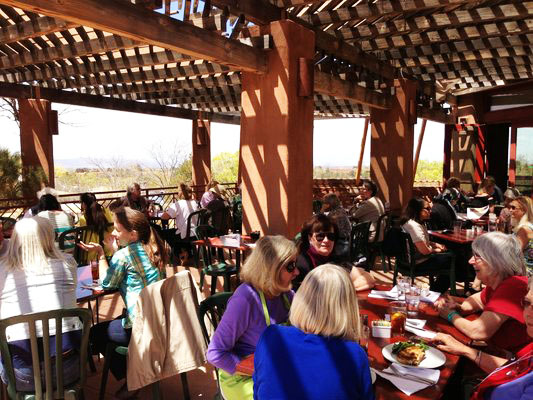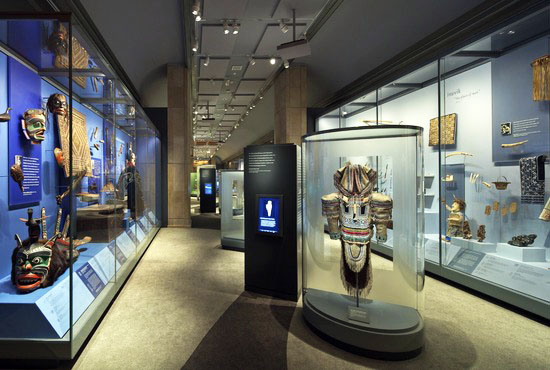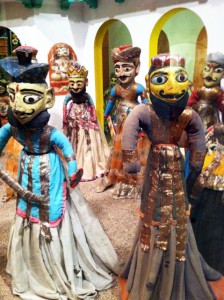Museum Hill is Santa Fe's very own internationally recognized art and history destination. To wander and explore the offerings at these museums is to gain a deeper understanding and appreciation of the three cultures that have merged to form a rich heritage, which is the union of Native American, Spanish, and Anglo traditions. The exploration of a fantastic museum is an immersion in history and stories. A magnificent exhibit leaves me changed somehow (and admittedly, smarter). Museum Hill provides ample opportunities to ignite inspiration, and deepen your appreciation of art and the cultures that bring it to life in its many forms, and to come away with a new way of looking at the world.
See Cultural Evolution at the Museum of International Folk Art
One of my all-time favorite museums is the Museum of International Folk Art. The permanent Girard Collection, from famed textile designer Alexander Girard, is a hearty explosion of color, cultural diversity, and sheer whimsy. There are more than 120,000 objects on display ranging from primitive puppets, elaborately carved dolls, and animal figures, strange otherworldly masks, and fantastic tableaus that depict birth, death, nature, religion, saints, and sinners. It is a fascinating glimpse into a way of storytelling through the use of tangible objects.
The seeds for this stunning folk art collection were sown during Girard’s honeymoon to Mexico, when he and his wife returned to the United States with their car loaded down with treasures. The Girards settled in Santa Fe in 1953, and in 1978 made the gift of more than 100,000 objects to establish the Girard Foundation. Girard personally installed the exhibit, and his love of design and object placement is truly a sight to behold.
I wandered this exhibit for nearly two hours before finding my way to the "New World Cuisine: The Histories of Chocolate, Mate' Y Mas" exhibit. The results of the melting pot (pun intended) of cultures and flavors are evident today. It’s eye opening to examine ancient kitchen tools and dishware, silverware and copper pots, and realize how far we've come, yet how true to form our modern kitchens still are. I was struck with the genius of the utilitarian pieces, and the simple beauty of the decorative displays. Williams-Sonoma has some serious competition here!
These cool artifacts also show the progression of fusing America's traditional crops like beans, squash and corn, with new and exotic spices, vegetables, and meats brought by the Spanish and other settlers. Santa Fe has long been heralded as a go-to culinary destination, and most foodies know the region for hearty ingredients like native chile, corn and squash. But, surprisingly, chocolate has been a coveted New Mexico delicacy for more than a century. (Check out my previous post to find out how to savor your own indulgent chocolate tour.) Archaeologists have found traces of theobroma (chocolate’s scientific name; it means “food of the gods”) in Chaco Canyon pottery shards.

The New World Cuisine exhibit at Museum of International Folk Art showcases the influence ancient culinary tools and dishware on our modern kitchens
It’s been said that when Don Diego DeVargas marched north for the re-conquest of Santa Fe, each of his soldiers carried a wedge of chocolate all the way up the Camino Real, enticing his enemies into chocolate-fueled negotiations. Chocolate has been winning wars and wooing lovers for centuries. It's history, from Mezo-America to China is a fascinating one, and this exhibit illustrates how chocolate has become a staple in many cuisines.
Refuel at Museum Hill Café
If the wandering and culinary displays leave you hungry, be sure to stop by the Museum Hill Café, which sits amidst the common courtyard shared by several of the museums. There, you can refuel with a fantastic variety of fresh food, ranging from Asian shrimp or steak tacos, nachos, yummy soups salads, to a great selection of sandwiches and quiches. This lunch spot is airy and welcoming with a spectacular view and patio, and also boasts homemade desserts, coffee, beer, and wine.
The Café offers a delicious New World Cuisine Cafe Sampler Plate to accompany the New World Cuisine exhibit. The plate is $14 for one or $24 for two, with a fabulous $9 wine pairing. Delectable offerings include sweet corn custard, Jalisco sopes, nopal salad, poblano mole, and a divine dark chocolate truffle gram tart. I love the concept of tying in a feast for my eyes at the museum, with a feast for my taste buds at the café.
 Refuel with tacos, salads, wine, or coffee — with a spectacular view — in between exhibits at the Museum of International Folk Art at the café.
Refuel with tacos, salads, wine, or coffee — with a spectacular view — in between exhibits at the Museum of International Folk Art at the café.Past Meets Present at Museum of Indian Arts & Culture
Just across the courtyard is the Museum of Indian Arts & Culture, whose mission is "to inspire appreciation for and knowledge of the diverse native arts, histories, languages, and cultures of the Greater Southwest." For a relatively small museum, the scope of this vision is great, but the mix of ancient artifacts with modern components brings the mission to reality.
 Each basket’s unique pattern and artistry tells a story at the “Woven Identities” exhibit at the Museum of Indian Arts & Culture
Each basket’s unique pattern and artistry tells a story at the “Woven Identities” exhibit at the Museum of Indian Arts & CultureThe ties to the past are evident throughout the museum, and I was aware of a deeper respect growing in me. Seeing the handiwork of the tools, stoneware, baskets, beading, and leatherwork truly commands a reverence for what the times and landscape (literal and socioeconomic) must have been. The current exhibit, "Woven Identities," features baskets woven by artists representing 60 cultural groups in six culture areas of Western North America. Each basket, with its unique patterns and artistry, tells a story. Although the names of the weavers are largely unknown, it’s easy to imagine the person who constructed these beautiful pieces. I left feeling humbled and enlightened of the fortitude and inherent skills that these artists incorporated into their work. The expression of their individuality is revealed in each fiber.
The Personal Pursuit of Navajo Heritage at Wheelwright Museum
Another smaller museum that houses an impressive collection of Native American artifacts is the Wheelwright Museum. The current exhibit, "A Certain Fire: Mary Cabott Wheelwright Collects the Southwest," showcases the museum's namesake and her unyielding passion for preserving native culture. Her purpose in opening the museum (celebrating its 75th year) was to create a home for items that supported the study and practice of Navajo ceremonialism.
Eventually, her collection came to encompass a wider range of tribes throughout the Southwest. With the assistance of scholars, artists, and collectors, Wheelwright filled her museum with weaving, artworks, archives, and other items, helping to preserve one of the world’s great religious traditions. I loved seeing these exquisite pieces, and Wheelwright's own writings and photographs give the exhibit intimacy and a personal touch. Be sure to check out the gift shop, the rustic and authentic Case Trading Post. There you will find fair trade baskets, weavings, jewelry, books, and pottery from local artists.
 Mary Cabott Wheelwright's unyielding passion for preserving Native culture is felt throughout the Wheelwright Museum
Mary Cabott Wheelwright's unyielding passion for preserving Native culture is felt throughout the Wheelwright MuseumSee New Peruvian Works at the Museum of Spanish Colonial Art
The Spanish Colonial Arts Society recently opened to the public its largest permanent gift of Peruvian art in its 88-year history. The “Window on Lima: the Beltrán-Kropp Collection from Peru” exhibit includes 40 objects from Peru, as well as a number of objects from other countries collected by Pedro Gerardo Beltrán Espantoso and his wife Miriam Kropp Beltrán. Pedro was a descendent of a Spanish conquistador and a member of the Peruvian aristocracy who served as Peru’s ambassador to the United States in the 1940s. Dignitaries and royalty were often entertained at their lavish home, and this exhibit allows us modern day civilians to see for ourselves how this family lived.
I am buzzing to everyone about this exhibit, which includes a rare reverse-painted glass frame from Cajamarca, Peru, an exquisite silver panel of Abraham, Isaac and the Angel, and a table with marquetry of incised ivory and tortoise shell. There’s also an entire set of Beltrán custom-made and engraved cobalt blue and gold dinner service for 46 people. I’d love to be invited to that dinner party! Tinwork, silver, gilded gold, carvings, and etchings all comprise this ornate style. I also love an excuse to admire the Museum of Spanish Colonial Art, located in a historic, Pueblo Revival-style building, on the north side of Museum Hill. Check my past post all about exploring this exquisite museum. [Link: http://santafe.org/blog/?p=194]
Get Enlightened at Museum Hill
Santa Fe is truly fortunate to be the home to these unique museums that give other art destinations a run for their money. You will come away with an enriched appreciation for this distinct part of the world that combines preservation of the past with modern artistry, all atop a magical hill.










